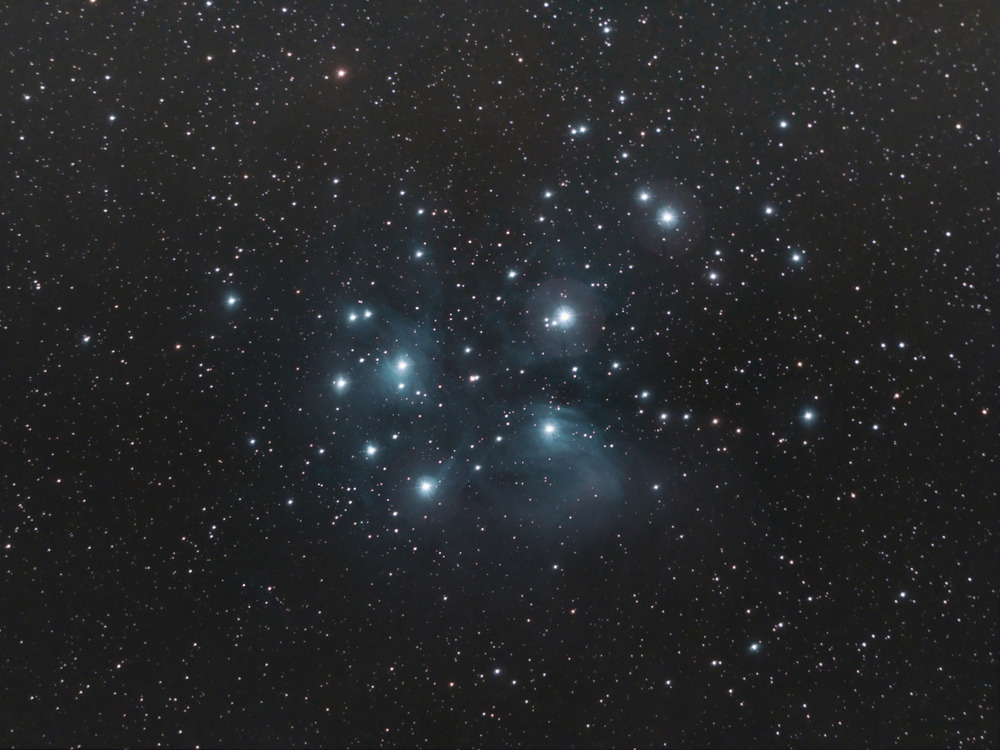First Look: The Astro-Tech 8” f/4 Astrograph
| Price |  |
| $449.00 | |
| Highest Useful Magnification | |
| 320x | |
| Focal Length | |
| 800mm | |
| Focal Ratio | |
| f/4 | |
| Resolution | |
| 0.57 arc seconds | |
| Visual Limiting Magnitude | |
| 14 | |
| Aperture | |
| 8" | |
| Net Weight | |
| 21.6 lbs. | |
| Heaviest Single Component | |
| 18 lbs. |
Present at the unveiling were Leon Bujkaker, the proud owner of this animal, Charlie Hein, Director of SFAAA, Charles Lillo, Director-at-large, Steve Cox (an imminent owner himself), Joe Moskowitz, and the author. We were all impressed with the build quality of the instrument; I was personally interested in the comparison between it and an analogous product from Orion. I believe it’s fair to say that when a company can beat out Orion for value then they have accomplished something. We did not have a copy of the Orion to compare it to, but there is certainly one distinction that is evident: for the same price, the Astro-Tech offers the same telescope as Orion does but with substantial knife-edge baffling. This is where the Astro-tech is clearly superior, if for no other reason.

Here we see the baffling extending all the way down the tube, including a significant part that is placed ahead of the secondary. This is a major design difference that separates it from the Orion, as the Orion’s tube does not extend much past the secondary.
 The business end during laser collimation, showing baffling.
The business end during laser collimation, showing baffling.
The first order of business was assembly with rings and dovetails; the equipment that had been selected were (2) 13” Synta-type rails from ADM and the rings that came with the OTA. This created a nice, wide footing on the rail with ample room for adjustment on the saddle. Mr. Cox was quick to point out that this arrangement sadly obscured the view of the cool Astro-Tech lettering on the side (not shown).
 Charlie and Charley secure the mounting harness
Charlie and Charley secure the mounting harness
Once the hardware was in place and the tube was secure, with top and bottom rails firmly in place, it was time to collimate. Collimation was a breeze and took no time at all to get the mirrors lined up. This was done with a laser collimater from Orion. Mr. Hein demonstrated proper procedure by adjusting the secondary mirror first; once that was square it was onto the primary. Another quality note: Unlike the Orion, which uses BAK-7 (Soda Lime glass), the Astro-Tech employs BK7-equivalent optical glass mirrors, aluminized and overcoated with quartz (thanks to Mr. Cox for that important technical distinction).
 Sir Hein adjusting the secondary
Sir Hein adjusting the secondary
One issue that surprised us was the force needed to pry off the front cover. This was a telescope that did not want to see anything.
As is to be expected, the telescope was way out on both mirrors. Note to self: Don’t bother getting one of these without a handy-dandy laser collimator.
 Like the Orion, the Astro-Tech boasts a cooling fan for the primary:
Like the Orion, the Astro-Tech boasts a cooling fan for the primary:
An important feature of contemporary telescopes is the quality of the focusers – companies don’t bother selling any telescope that is designed for imaging nowadays without a dual-speed focuser. The stock focuser for the Astro-Tech was smooth though the entire length of its draw tube but it was not properly tested with a full size camera to determine whether or not it will be robust enough for fine focusing that this f/4 newt will surly need.
 A nice Feather Touch or Moonlite focuser would be a nice upgrade.
A nice Feather Touch or Moonlite focuser would be a nice upgrade.
Assembled and collimated, the instrument was ready for its partner in crime, the guidescope. Being a man of taste and distinction Leon opted for a beautifully matching Williams Optics 66, with rings from ADM.
 That’s a nica-lookin’ scope, no?
That’s a nica-lookin’ scope, no?
Now the assembly was ready for placement on an Atlas mount, generously shared for the occasion by the author. We tried to recreate the circumstances of an imaging session by placing a QHY8 camera at the eyepiece. Balancing was very tricky as is to be expected with such a lopsided load, and it is noted that a set of weights (felt covered magnets?) are necessary to adequately balance the OTA and compensate for the front/side-load of the imager.
 Assembled and mounted
Assembled and mounted
It was this writer’s ambition to pull down some images from the large-format QHY8 to get a feel for the curvature of the field and the vignetting that one might expect from a fast, inexpensive non-hyperbolic Newt. Sadly this writer brought his camera but forgot his powerbox, and by the time Steve came to the rescue the clouds had rolled in. But we put the moon in the eyepiece and, while the view was nice, it was clear that without a corrector lens (due for release soon by the manufacturer) this telescope is useless for large-format cameras.
Charlie Hein (L) and Leon
I’ve been a dedicated to Squarespace fan for 20 years. Love the product, people and company.




